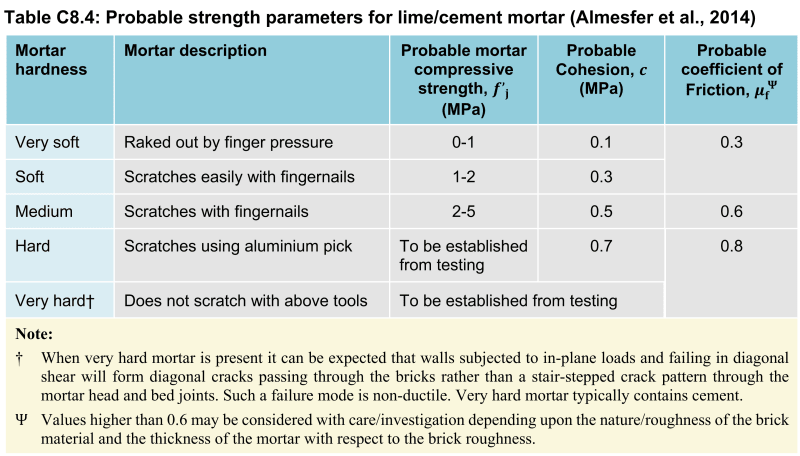Ben_StructEng
Structural
Hi All,
I'm in Australia and I'm currently trying to justify a significant concentrated load applied from a steel beam to a 110mm thick existing clay masonry wall.
The building was built in approximately the 1950's-1960's and is vertically supported and laterally stabilised by many 110mm thick clay brick walls. One of the walls is to be removed and replaced with a steel beam over, which is going to be supported on the 110mm thick walls with a bearing plate.
I can justify the masonry capacity to AS3700: Masonry Structures if I assume 20Mpa unconfined compressive capacity and a mortar class of M3 or better, though this is likely to be unconservative due to the age of the building.
What I am after is some guidance on clay masonry historic unconfined compressive capacity (in Australia - In particularly Sydney) and some information on the typical mortar mixes of that era (and other era's) that allows me to get some confidence in the actual properties of clay masonry in historic buildings.
I'm not the first person in the world to have specified a new beam in replacement of a masonry wall and assumed some properties for the existing, though where is everyone getting this historical information? And how are they relying upon it without testing?
If I need to get into testing, it will likely cost the client more than what it is worth, and re-framing the system to dump less shear in one location is not always viable. Nor is adding steel columns/new engaged piers etc. and having other issues like slab punching shear etc. at their base.
Can anyone advise on this?
Thanks.
I'm in Australia and I'm currently trying to justify a significant concentrated load applied from a steel beam to a 110mm thick existing clay masonry wall.
The building was built in approximately the 1950's-1960's and is vertically supported and laterally stabilised by many 110mm thick clay brick walls. One of the walls is to be removed and replaced with a steel beam over, which is going to be supported on the 110mm thick walls with a bearing plate.
I can justify the masonry capacity to AS3700: Masonry Structures if I assume 20Mpa unconfined compressive capacity and a mortar class of M3 or better, though this is likely to be unconservative due to the age of the building.
What I am after is some guidance on clay masonry historic unconfined compressive capacity (in Australia - In particularly Sydney) and some information on the typical mortar mixes of that era (and other era's) that allows me to get some confidence in the actual properties of clay masonry in historic buildings.
I'm not the first person in the world to have specified a new beam in replacement of a masonry wall and assumed some properties for the existing, though where is everyone getting this historical information? And how are they relying upon it without testing?
If I need to get into testing, it will likely cost the client more than what it is worth, and re-framing the system to dump less shear in one location is not always viable. Nor is adding steel columns/new engaged piers etc. and having other issues like slab punching shear etc. at their base.
Can anyone advise on this?
Thanks.


